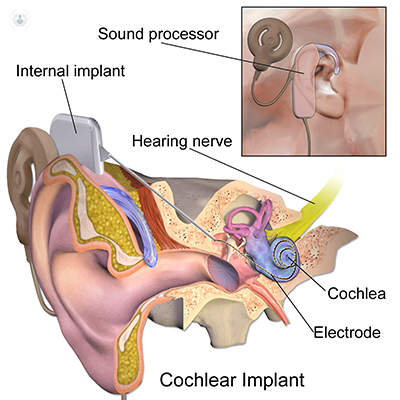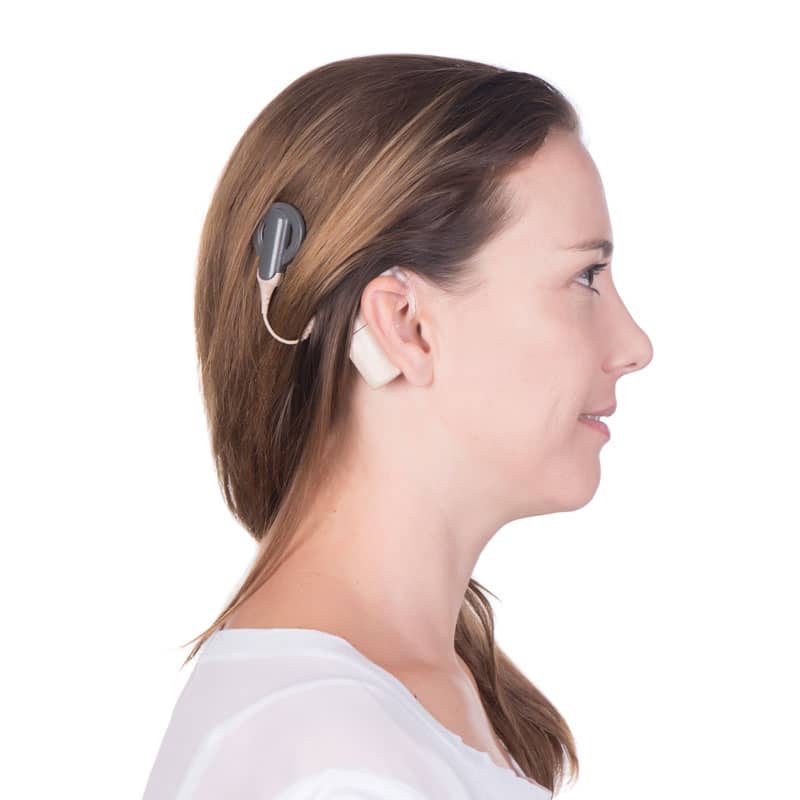Removing an acoustic neuroma can lead to single-sided deafness SSD. Acoustic Neuroma Association 600 Peachtree Parkway Suite 108 Cumming GA 30041 The ANA is a 501c3 nonprofit organization Tax ID 23-2170836.
Bone Anchored Hearing Aid Dr Sharon Ovnat Tamir
Audiological results Skull base tumors and in particular vestibular schwannoma VS are among the etiological reasons for single-sided deafness SSD.

Baha implant acoustic neuroma. For patients with neurofibromatosis type 2 who develop acoustic neuromas in both ears causing deafness cochlear implants or auditory brain stem implants can help provide a sense of sound and. At long last I now have a way to hear from my deaf side and will gradually gain back my radar. We then make a hole into the skull and a small titanium screw with a connector attached to it is screwed into place.
They allowed me to do a BAHA simulation in the office so that I could see what. Single Sided Deafness SSD The Baha System is also indicated for patients with a unilateral sensorineural deafness or SSD. Baha implant as a hearing solution for single-sided deafness after retrosigmoid approach for the vestibular schwannoma.
Most patients express a clear preference for the BAHA over. This type of hearing aid consists of a small titanium screw. Partially Fully Funded You will receive a free Hearing Test all funding for your new Hearing Aids and any accessories you might need.
The Baha offers an alternative method for achieving sensitive hearing by the way of Bone Conduction. The Baha works on a principle of efficient coupling of the sound processor to the underlying bone through 1 a small connector across the skin and 2. Unlike hearing aids the bone-anchored systems includes an implant -- the titanium fixture -- that osseointegrates ie.
The Baha System uses the bodys natural ability to transfer sound. Because Im completely deaf in my left ear and my hearing is great in my right ear I am a candidate for BAHA. Single-sided deafness SSD Cholesteatoma Acoustic neuroma Middle ear diseases Contact Us Today Book Appointment How BAHAs Work Typically bone-anchored hearing devices have three parts.
Acoustic neuroma or vestibular schwannoma is a tumour on the vestibulocochlear nerve. Hearing loss from an acoustic neuroma is due to the surgical removal of benign tumors developing on the nerve that connects the ear to the brain. Last week I went for a follow up appointment with my Otologist and was introduced to the BAHA Bone Anchored Hearing Aid implant.
I am forever grateful In February 2010 I was diagnosed with what we thought was Bells palsy. Acoustic neuroma is a non-cancerous brain tumour that develops on the hearing and balance nerve which connects the inner ear with the brain. However only 25 of the patients wished implantation for BAHA treatment.
Audiological indications For SSD the Baha System is indicated when the PTA AC threshold of the normal ear is better than or equal to 20dB HL though 3000 Hz. If you struggle to hear because of chronic conditions such as draining ears chronic ear infections acoustic neuroma or Microtia and Atresia a Baha Bone Conduction Implant System may be the solution you have been waiting for. She concedes that even if radiosurgery had been an option she wanted to get the tumor out of her head.
In April 2004 I got a notice from House Ear Institute that they were having a seminar to talk about BAHA which had been approved by the FDA a year before as a solution for. BAHAs may also benefit patients with. ABOUT THE BAHA This is a very effective device which has been around for over 25 years.
An acoustic neuroma is one common cause of single-sided deafness. Hearing in work meetings crossing the street and even. When an acoustic neuroma is removed the implant can be placed at the time of removal or a few months later.
Surgery is minor and Baha recipients report a wide range of advantages over other hearing devices. After surgery her acoustic neuroma was gone but unfortunately so was her hearing. Instead of trying to push sound through the damaged area in the outer or middle ear it reroutes the sound directly through bone from the damaged ear to the working inner ear on the other side.
The system converts sound waves into vibrations which the implant and the abutment carry to the bony portion of the skull. Grows into bone with living tissue to form a permanent functional bond with the bone of the skull. Patients who wear a conventional BC hearing aid are generally most suitable for this procedure.
A titanium implant is. The Baha system combines a sound processor that clips onto a surgically implanted small titanium protrusion. It is usually benign and modern microsurgical techniques generally offer safe and effective removal of the tumour but the treatment often leads to.
By using your bodys natural ability to. A bone-anchored hearing aid or BAHA is a device that conducts sound directly to the cochlea using the skull bypassing the other portions of the ear. What Does the Baha Sound Processor Look Like.
Once in place it will eventually fuse with the temporal bone so sound can transmit directly through the structure. This study shows that unilateral deafness after acoustic neuroma surgery is thought as a handicap in most of the patients and confirms that treatment with the BAHA has positive subjective effects and improves speech discrimination in noise. BAHA - Bone Anchored Hearing Application.
In an outpatient procedure using local anesthesia a surgeon places the screw in the skull behind the non-hearing ear. The Baha system is an innovative technology that has been approved by the Food and Drug Administration to treat hearing loss. Patients with SSD due to acoustic neuroma surgery sudden deafness etc who for some reason cannot or do not want to use a CROS hearing aid.
Isolation and frustrating conversations led Jeffrie Anne to explore other solutions. A Romberg test touching fingers to the nose caused her to fall over and an MRI with contrast revealed a 37 cm acoustic neuroma. During a minor outpatient surgical procedure the titanium fixture is placed in the mastoid bone behind the ear.
The BAHA System is implanted in the temporal bone just behind the ear under local anesthesia. For ongoing hearing issues after acoustic neuroma surgery a doctor may recommend a bone-anchored hearing aid cochlear implant or a regular hearing aid. The titanium implant is integrated into the mastoid bone behind the non-functioning ear.
The BAHA system uses an osseointegrated titanium implant to propagate sound directly to the inner ear through the skull bypassing the impedance of the skin and subcutaneous tissues. Single-sided deafness can make life more difficult. The Baha System is indicated for patients who have a conductive or mixed hearing loss and can still benefit from amplification.
Luckily she was introduced to the Cochlear Baha System. A small area of skin behind the ear is lifted up and all the fat and muscle underneath is removed to expose the bone. Surgical Implantation of BAHA One component of the BAHA system is an abutment that is surgically placed in the skull Fig.
Nancy did research and interviewed several doctors before proceeding to surgery.

Cochlear Implants Advanced Ear Nose Throat
No comments